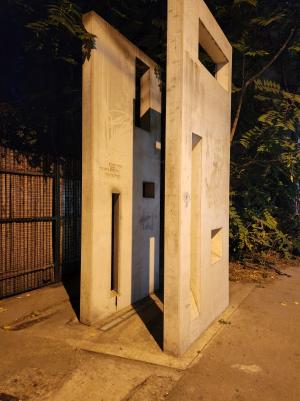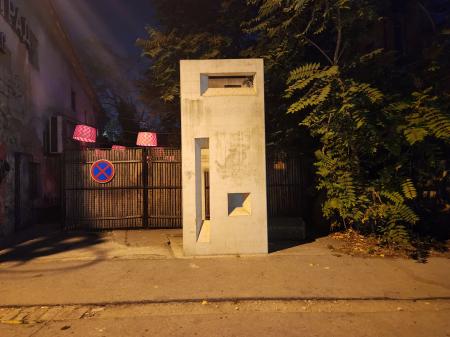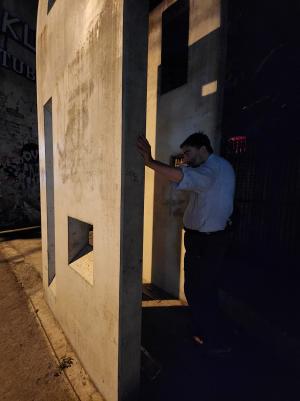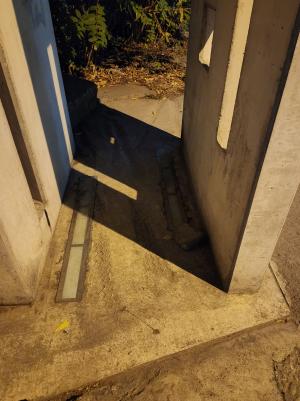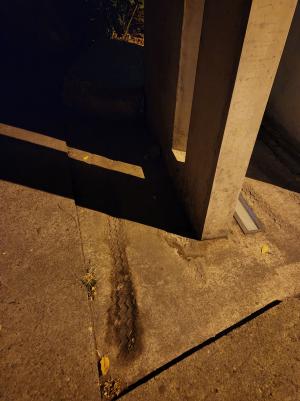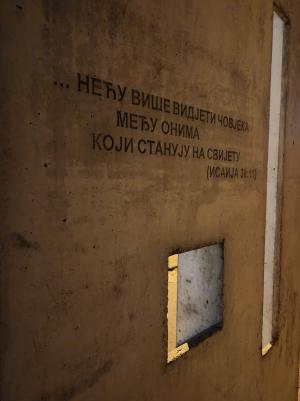Obj. ID: 53632
Memorials Gas Trucks Holocaust Memorial in Belgrade, Serbia

Name of Monument
Gas Truck Victims Memorial
(Spomenik Jevrejima stradalim u Dušegupki)
What/Who is commemorated
Victims of the Gas Vans
Description
The monument consists of two parallel upright rectangular concrete slabs, separated by a narrow passageway, meant to recall the confined spacer of the Jewish prisoners inside the gas-van. The outer slab faces the street and the one behind is obscured. Each slab is perforated with three window-like of differnet sizes, placed in different patterns.
Inscribed on the side of each slab facing inward – the passageway - is part of a verse from Isaiah (38: 11), in Hebrew on one side and Serbian on the other At the bottom of the monument, embedded in the concrete, is the impression of original "Continental" tire of the type used on the "Saurer" gas-van truck. Ana Korica, one of the designers of the monument, found the tire in a
warehouse in the Czech Republic after a lengthy search.
A narrative plaque in Serbian and English is affixed near the corner of the façade of the adjacent
building.
Inscriptions
On plaque affixed to adjacent wall, in Serbian and English:
HA OBOM MECTУ ПОЧИЊАЛА JE AГОНИЈА
JEBPEJCКИХ ЖEHA И ДEЦE ЗАТОЧЕНИКА
JEBPEJCКОГ ЛОГОРА ЗЕМУН (JUDENLAGER
SEMLIN), ФОРМИРАНОГ НА ТЕРИТОРИЈИ
НЕЗАВИСНЕ ДРЖАВЕ ХРВАТСКЕ НА
БЕОГРАДСКOM CAJMИШТУ. НА ПУТУ
СМРТИ ОД ЛЕВЕ ОБАЛЕ САВЕ ДО
СТРАТИШТА У ЈАЈИНЦИМА ОД КРАЈА
MAРTА ДО 10. MAJA 1942. У
КАМИОНУ-ГАСНОЈ КОМОРИ УБИЈЕНО JE
ОКО 6.300 ОСОБА. CPБИЈА JE ПOCTAЛА
JEДНО ОД ПРВИХ HEMAЧКИХ
ОКУПАЦИОНИХ ПОДРУЧЈА У EBPOПИ HA
КОЈЕМ ЈЕ СПРОВЕДЕН HAЦИCTИЧКИ ПЛАН
ПОТПУНОГ УНИШТЕЊА JEBPEJCКОГ
HAPOДА (ХОЛОКАУСТ).
Translation: The agony of the Jewish women and children of the prisoners of the Jewish Camp Zemun (Judenlager Semlin), formed on the territory of the Independent State of Croatia at the Belgrade Fairgrounds, began at this place. On the road of death from the left bank of the Sava to Stratišt in Janjinci from the end of March to May 10, 1942, about 6,300 persons were killed in the truck-gas chamber. Serbia became one of the first German occupation areas in europe where the Nazi plan for the complete destruction of the Jewish people (holocaust) was implemented.
IT IS FROM THIS SPOT THAT THE AGONY OF
JEWISH WOMEN AND CHILDREN STARTED.
THEY WERE THE PRISONERS OF JEWISH
CONCENTRATION CAMP IN ZEMUN,
ESTABLISHED ON THE FORMER BELGRADE
FAIRGROUNDS, AT THAT TIME THE
TERRITORY OF THE INDEPENDENT STATE OF
CROATIA. FROM THE END OF MARCH UNTIL
MAY 10TH 1942, AROUND 6.300 PEOPLE
WERE MURDERED ON THE DEATH PATH OF
THE GAS CHAMBER-TRUCK WHICH LED FROM
THE LEFT BANK OF THE SAVA TO THE
SCAFFOLDS IN JAJINCI.. SERBIA THUS BECAME
ONE OF THE FIRST TERRITORIES OCCUPIED BY
THE GERMANS IN EUROPE WHERE THE NAZI
PLAN OF TOTAL ANNIHILATION OF THE JEWS
(HOLOCAUST) WAS CARRIED OUT.
Hebrew verse inscribed in concrete:
בארץ החיים
לא אביט אדם עוד
עם יושבי חדל
The same verse in Serbian:
… НЕЋУ ВИШЕ ВИДЈЕТИ ЧОВЈЕКА
МЕЋУ ОНИМА
КОЈИ СТАНУЈУ НА СЕИЈЕТУ
(ИСАИЈА 38:11)
Translation: "I will no longer see a man among those who dwell on earth" (Isaiah 38:11)
Commissioned by
City Municipality of Savski Venac (Belgrade)
sub-set tree:
The Monument
The monument to the Jews who died in the gas-vans (Dušegupka) was erected at Branka Krsmanovića Street, between no. 2 and 4, in the City Municipality of Savski Venac, in Belgrade. The project was initiated by Branimir Gajić, a member of the municipal council, together with President of Savski Venac Regional Government Dušan Dinčić and his assistant Jasmina Đokić- Pavkov. Two million dinars (about 17,000 euros) were allocated from the municipal budget for the entire project. Sculptor Nikola Pešić and historian Milan Koljanin, associate of the Institute for Contemporary History, were appointed as members of an expert commission. Ambassador of Israel to Serbia Josif Levy and Dr. Ruben Fuchs, president of the Union of Jewish Municipalities of Serbia. The stark monument commemorating those killed in the gas-vans was dedicated in August 5, 2014 by Ambassador Levy and Regional Government President Dinčić.
What is Commemorated?
On March 10, 1942, a large "Saurer 6 GGF-L" truck (the first of 20), on whose chassis was mounted a large container without openings or windows, was unloaded from a freight car at the Zemun railway station. The truck had been modified at the Gaubschat Fahrzeugwerke GmbH factory in Germany to enable the transport and killing by exhaust gas up to 100 Jewish prisoners at a time. They were driven from the Old Fairgrounds over the bridge on the Sava River, when the truck reached the location of the present-day monument, one of the drivers was go under truck and direct the exhaust into the cabin. The vehicle moved through the central city streets, then along the road towards Niš to the foot of Avala, where it turned towards Jajinci and the already excavated mass graves. The truck then drove towards Jajinci and already excavate mass graves. Other prisoners were tasked with removing and burying the bodies.
According to witness statements collected after the war, there were about eighty mass graves, and it is estimated that about a hundred victims were buried in each of them. As the end of the war neared, the Germans began to remove traces of mass crimes in Serbia carried out by the Nazis. Between December 1943 and April 1944, the bodies buried in Jajinci were exhumed and burned, and the ashes were spilled into the Sava.
The process was repeated daily – sometimes several times a day - during the spring of 1942. The first victims were over 800 patients and staff of the Belgrade Jewish hospital, executed on March 18-19, 1942. Until May 10, 1942, about 6,300 more Jews were murdered in the same way. The drivers of the truck – officers Goetz and Meyer - were never found after the war, and presumably escaped punishment.
Jokić-Stamenković, D., „Spomenik Jevrejima ugušenim u dušegupki” ” Политика, December 15, 2013., https://www.politika.rs/sr/clanak/278641/Spomenik-Jevrejima-ugusenim-u-dusegupki (accessed April 30, 2024)
Jokić – Stamenković, D., „Spomenik Jevrejima stradalim u Dušegupki”, protivzaborava.com., https://www.protivzaborava.com/document/spomenik-jevrejima-stradalim-u- dusegupki/ (accessed April 30, 2024)
Komarčević, Dušan, „Sećanje na Holokaust: Spomenik jevrejskim žrtvama dušegupke”,
slobodnaevropa.org, March 6, 2014., https://www.slobodnaevropa.org/a/spomenik-jevrejskim- zrtvama-dusegupke/25285409.html (accessed April 30, 2024)
Mihajlović, Maja, „Da li ste se ikad zapitali koja simbolika se krije iza spomenika žrtvama Dušegupke?”, haver.rs., https://haver.rs/da-li-ste-se-ikada-zapitali-kakva-se-simbolika- krije-iza-spomen-obelezja-zrtvama-dusegupke/ (accessed April 30, 2024)
„Spomen-obeležje žrtvama Holokausta”, designed.rs. , https://web.archive.org/web/20200813151409/http:/www.designed.rs/living/arhitektura/spomen-obelezje_zrtvama_holokausta (accessed April 30, 2024)
Jokić-Stamenković, D. “Споменик Јеврејима угушеним у душегупки,” [Monument to the Jews suffocated in Dušegupka, ]” Политика (Politika), Dec. 15, 2013.
(https://www- politika.rs.translate.goog/scc/clanak/278641/?_x_tr_sl=sr&_x_tr_tl=en&_x_tr_hl=en&_x_tr_pto =sc)







